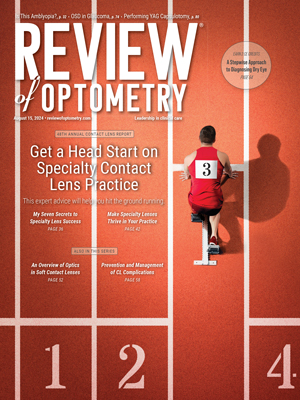 |
Q:
What are the best ways to deal with suspected preseptal cellulitis?
“It is important to correctly diagnose patients with this inflammatory disease,” says Anthony DeWilde, OD, a specialist at VA Telehealth. “Other conditions that may mimic it are mild orbital cellulitis, hordeola, viral infections such as herpes simplex or zoster or epidemic keratoconjunctivitis (EKC) and localized edema from an allergic reaction. Preseptal cellulitis will have more diffuse edema, present with pain and feel warm to the touch.”
Preseptal cellulitis is an infection of the skin causing localized erythema, edema and pain. It is important to differentiate preseptal from orbital (postseptal) cellulitis. While both arise from infection, orbital cellulitis has increased risk for infraorbital abscess and cavernous sinus thrombosis.1,2 Onset of symptoms after a hordeolum, bug bite, eyelid laceration or skin infections with a lack of visual changes suggest a preseptal infection.1
 |
|
Preseptal cellulitis in a patient with an incipient chalazion. Click image to enlarge. |
A great masquerader can be EKC, which can present with significant lid swelling in advanced cases and lead one to diagnose preseptal cellulitis, but the key finding here is that the eye itself will be significantly injected. True preseptal should present with a white quiet eye.
Patients with orbital cellulitis are more likely to present with history of sinus infection and symptoms including vision loss, diplopia, pain with eye movement, exophthalmos and fever. It is important to note that prepubescent children are at higher risk of orbital cellulitis.2,3
Due to the potential for life-threatening complications, orbital cellulitis should be referred to a physician who can image the orbits, hospitalize with IV antibiotics and potentially initiate surgery. While an oculoplastic specialist is best suited to treat these patients, an emergency room physician may be the best referral to start with.4,5
Patient Management
The best treatment for preseptal cellulitis is prompt initiation of oral antibiotics. The most common pathogens are gram-positive Staphylococcus and Streptococcus. Due to an increase in methicillin-resistant Staphylococcus aureus (MRSA), it is recommended that patients receive trimethoprim-sulfamethoxazole (TMP-SMX), clindamycin or doxycycline. However, TMP-SMX and doxycycline do not cover group A Streptococcus, and doxycycline is not recommended for children under eight years of age.4-7
“Older school treatment includes Keflex (cephalexin, Advancis Pharmaceutical) 500mg BID for mild cases or 500mg QID for more advanced cases,” says Dr. DeWilde. The current literature is shifting away from this, however, and pointing toward clindamycin, TMP-SMX plus amoxicillin-clavulanic acid, cefpodoxime or cefdinir.7 If a patient is immune-compromised, the potential for fungal infection greatly increases.
According to Dr. DeWilde, patients should be monitored closely due to the risk of progression to orbital cellulitis. If symptoms worsen within 24 to 48 hours, prompt referral should be initiated.
Dr. Ajamian is board certified by the American Board of Optometry and serves as Center Director of Omni Eye Services of Atlanta. He is vice president of the Georgia State Board of Optometry and general CE chairman of SECO International. He has no financial interests to disclose.
1. Gordon AA, Phelps PO. Management of preseptal and orbital cellulitis for the primary care physician. Dis Mon. 2020;66(10):101044. 2. Tsirouki T, Dastiridou AI, Flores NI, et al. Orbital cellulitis. Surv Ophthalmol. 2018;63(4):534-53. 3. Wong SJ, Levi J. Management of pediatric orbital cellulitis: a systematic review. Int J Pediatr Otorhinolaryngol. 2018;110:123-9. 4. Lee S, Yen MT. Management of preseptal and orbital cellulitis. Saudi J Ophthalmol. 2011;25(1):21-9. 5. Jones DB, Steinkuller PG. Strategies for the initial management of acute preseptal and orbital cellulitis. Trans Am Ophthalmol Soc. 1988;86:94-108. 6. Monsivais-Rodríguez FV, Yen MT, Tsui JC, Burkey CN. Preseptal cellulitis. EyeWiki. eyewiki.aao.org/preseptal_cellulitis. Last updated April 18, 2024. Accessed July 2, 2024. 7. Bourget D, Bae C. Periorbital cellulitis. StatPearls. www.ncbi.nlm.nih.gov/books/NBK470408/. July 17, 2023. Accessed July 2, 2024. |

